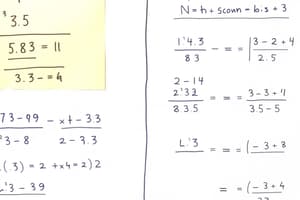Podcast
Questions and Answers
What is the purpose of defining the extent of the reinsured's liability in a treaty?
What is the purpose of defining the extent of the reinsured's liability in a treaty?
- To allocate all losses to the reinsurer
- To specify penalties for the reinsured
- To determine shared responsibility during heavy losses (correct)
- To eliminate the need for premium reserves
Which of the following correctly describes premium reserves?
Which of the following correctly describes premium reserves?
- They are a legal obligation to maintain funds in physical cash
- They represent a portion of the ceded premium held for future claims (correct)
- They are only required by the reinsurer
- They are a fixed percentage of the reinsured's assets
What role does the letter of credit play in the context of claims or loss reserves?
What role does the letter of credit play in the context of claims or loss reserves?
- It acts as a guarantee that all claims will be paid directly by the reinsurer
- It allows the reinsured to draw funds from a mutually acceptable bank under specific terms (correct)
- It eliminates the need for maintaining cash reserves completely
- It serves as a financial penalty for default on the contract
Which of the following factors is NOT typically defined within a reinsurance treaty?
Which of the following factors is NOT typically defined within a reinsurance treaty?
Why were premium and claims reserves developed as a safeguard for the reinsured?
Why were premium and claims reserves developed as a safeguard for the reinsured?
What is the primary characteristic of a proportional reinsurance treaty?
What is the primary characteristic of a proportional reinsurance treaty?
Which of the following statements best describes the role of commissions in proportional reinsurance?
Which of the following statements best describes the role of commissions in proportional reinsurance?
What is meant by premium and claims reserves in proportional reinsurance?
What is meant by premium and claims reserves in proportional reinsurance?
In the operation of proportional reinsurance treaties, cession limits refer to what?
In the operation of proportional reinsurance treaties, cession limits refer to what?
What distinguishes earned premiums from unearned premiums in proportional reinsurance?
What distinguishes earned premiums from unearned premiums in proportional reinsurance?
Which accounting method is primarily used in managing proportional reinsurance treaties?
Which accounting method is primarily used in managing proportional reinsurance treaties?
What is the significance of event limits in proportional reinsurance treaties?
What is the significance of event limits in proportional reinsurance treaties?
Which description best defines non-proportional treaties compared to proportional treaties?
Which description best defines non-proportional treaties compared to proportional treaties?
What is a significant characteristic of quota share treaties regarding the selection of risks?
What is a significant characteristic of quota share treaties regarding the selection of risks?
What factor does NOT influence the size of a commission in reinsurance arrangements?
What factor does NOT influence the size of a commission in reinsurance arrangements?
Which of the following is an advantage of quota share treaties?
Which of the following is an advantage of quota share treaties?
What is a disadvantage of a quota share treaty related to profitability?
What is a disadvantage of a quota share treaty related to profitability?
Which characteristic typically corresponds with flat-rate commissions?
Which characteristic typically corresponds with flat-rate commissions?
How does a quota share treaty affect the insurer's ability to vary its retention risk?
How does a quota share treaty affect the insurer's ability to vary its retention risk?
What does a higher flat-rate commission typically indicate?
What does a higher flat-rate commission typically indicate?
What is the timeframe for settling balances after submitting quarterly accounts in a quota share treaty?
What is the timeframe for settling balances after submitting quarterly accounts in a quota share treaty?
In which situation are flat-rate commissions likely to be lower?
In which situation are flat-rate commissions likely to be lower?
In what situation must an insurer resort to facultative reinsurance when using a quota share treaty?
In what situation must an insurer resort to facultative reinsurance when using a quota share treaty?
What is a potential outcome if a reinsurance treaty proves to be very profitable?
What is a potential outcome if a reinsurance treaty proves to be very profitable?
How does the commission for surplus treaty arrangements generally compare to quota share arrangements?
How does the commission for surplus treaty arrangements generally compare to quota share arrangements?
Which of the following statements about the relationship between insurer and reinsurer in a quota share treaty is true?
Which of the following statements about the relationship between insurer and reinsurer in a quota share treaty is true?
When might a reinsurance commission be reduced?
When might a reinsurance commission be reduced?
What unintended benefit does sharing risks through a quota share treaty provide to an insurer?
What unintended benefit does sharing risks through a quota share treaty provide to an insurer?
Which of the following does NOT typically influence the percentage of a flat-rate commission?
Which of the following does NOT typically influence the percentage of a flat-rate commission?
What primary liability does a reinsurer accept upon the transfer of unexpired policies?
What primary liability does a reinsurer accept upon the transfer of unexpired policies?
In non-proportional treaties, how is the reinsurance premium determined?
In non-proportional treaties, how is the reinsurance premium determined?
Why are reinsurers generally unwilling to allow reductions in reinsurance premiums by way of commission?
Why are reinsurers generally unwilling to allow reductions in reinsurance premiums by way of commission?
What is the role of ceding commissions in proportional treaties?
What is the role of ceding commissions in proportional treaties?
What assumption is made from the start regarding the profitability of a proportional treaty?
What assumption is made from the start regarding the profitability of a proportional treaty?
Which option best describes the nature of risks retained by the reinsured in non-proportional treaties?
Which option best describes the nature of risks retained by the reinsured in non-proportional treaties?
What is a primary characteristic of proportional reinsurance contracts?
What is a primary characteristic of proportional reinsurance contracts?
What is a key factor to consider for the success of a proportional treaty?
What is a key factor to consider for the success of a proportional treaty?
Flashcards are hidden until you start studying
Study Notes
Proportional Reinsurance Treaties
- Characteristics:
- Agreement between insurer and reinsurer for automatic acceptance of all risks within treaty limits.
- Insurer cedes risk, reinsurer accepts automatically.
- Facilitates immediate cover for insured proposals within treaty scope.
- Includes quota share treaties, which are used to restore balance after periods of poor results or as a means of maintaining reinsurance capacity.
- Also includes group insurance arrangements where subsidiaries within a large organization share risks to mitigate potential losses.
- Provides natural catastrophe reinsurance capacity for the insurer because all risks are shared proportionally.
Advantages and Disadvantages of Quota Share Treaties
Advantages
- Absolute relationship between insurer and reinsurer.
- Simple accounting and reporting.
- No upfront costs, balances settled after quarterly accounting.
- Flexibility in adjusting quota share at each anniversary.
- Unlimited loss recoveries for individual or aggregated risk events.
Disadvantages
- Cession of substantial income, potentially detrimental if business is profitable.
- Inflexible, insurer cannot choose to vary retention risk for individual risks.
- Requires alternative reinsurance methods for risks outside treaty scope.
- Insurer bound by treaty terms, including liability for transferred risk.
Commissions and Deductions
- Ceding commissions: Payments made by reinsurers to insurers to compensate for acquisition and administration costs.
- Factors influencing commission amount: Type of reinsurance, profitability history, market conditions, original commission paid by insurer, ceding insurer's administrative costs.
Types of Commissions
- Flat-rate commission: A percentage of gross premiums ceded, adjusted based on reinsurance type, business class, and other factors.
- Profit commission (flat-rate basis): Additional commission granted if treaty is profitable, calculated based on loss ratio and designed to offset unusually heavy losses.
Premium and Claims Reserves
- Premium reserve deposit: A proportion of the ceded premium held by the reinsured to ensure payment of justified claims if the reinsurer defaults.
- Claims or loss reserve deposit: An estimate of outstanding losses held by the reinsured to protect them from reinsurer default.
Cession and Event Limits
- Cession Limit: The maximum amount of risk that can be ceded to the reinsurer under the treaty.
- Event Limit: The maximum amount of loss that the reinsurer will cover for a single event, even if the total loss exceeds the cession limit.
Key Points
- Proportional reinsurance treaties are a vital tool for managing risk and ensuring financial stability.
- Careful consideration must be given to the various factors involved in selecting the appropriate treaty type, commission arrangements, and reserve requirements.
- This type of reinsurance provides benefits such as increased capacity, risk diversification, and cost savings.
- However, it is important to understand the potential downsides, such as the cession of profits and limited flexibility.
Studying That Suits You
Use AI to generate personalized quizzes and flashcards to suit your learning preferences.




